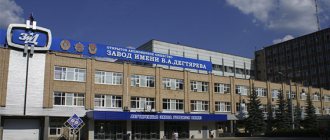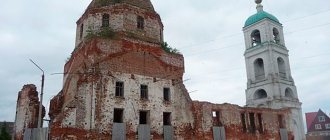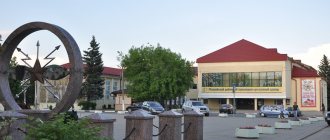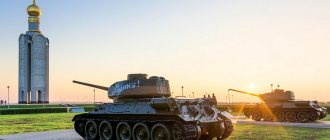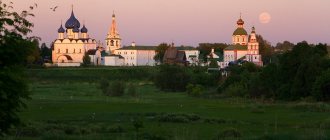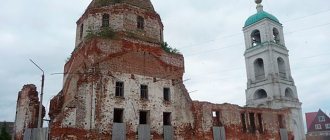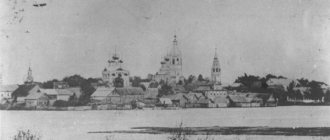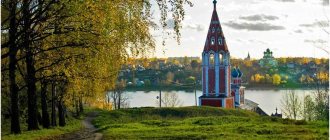Countries > Russia
Vladimir is one of the oldest cities in Russia with a rich history and part of the popular Golden Ring tourist route. He managed to preserve most of the historical heritage, so there are many unique monuments of ancient Russian art and architecture, and on the central streets it is easy to mentally transport yourself back several centuries. What you should visit during your visit and what sights you need to see are in this post.
- Attractions
- Interesting places
- Map
UNESCO heritage in the city of Vladimir
The history of Vladimir as the capital of Rus' began not in the city itself, but 10 km from it - in Bogolyubovo, where in 1155 the horses carrying the icon of the Mother of God from Kyiv suddenly stopped. The night spent in prayer served as a revelation for Prince Andrei Bogolyubsky and became a turning point in the history of Vladimir-on-Klyazma. The Mother of God commanded to leave her image in this city. Since 1160, the icon began to be called Vladimir, and the city itself turned into the capital. Prince Andrey spared no expense and effort in its arrangement: three architectural masterpieces of the 12th century in Vladimir itself are today included in the list of UNESCO World Heritage Sites.
Ferris wheel "Sky 33"
The main tourist “pearl” of Vladimir’s Central Park appeared in 2015, causing a great stir in the city and its surroundings. Thousands of people wanted to ride the 50-meter Ferris wheel and see the city from a bird's eye view. The new design turned out to be the only one in the area in terms of dimensions, so the flow of people wanting to ride has not dried up to this day. The 15-minute journey allows you to enjoy a complete panorama of the surrounding area: the wheel is positioned in such a way that people sitting in the cabins can see all areas perfectly. In total, the attraction contains 32 cabins and can accommodate 192 visitors.
Assumption Cathedral - the main temple of Vladimir Rus'
The cathedral for the miraculous icon was erected on the bank of the Klyazma River in 1158. The temple was built according to Byzantine canons, but Russian craftsmen added a unique flavor to the external design and created a masterpiece. The building stands out with its dazzling whiteness against the background of the surrounding nature.
Nowhere else, except in Zalesskaya Rus', were temples built from white stone - it was a very expensive and labor-intensive material to process. In height, the Assumption Cathedral surpassed all buildings in Rus', including the St. Sophia Cathedrals of Kyiv and Novgorod. The upward thrust was reinforced by architectural techniques: pilasters - vertical relief strips separating monolithic facades; zakomars are semicircular ends of the walls. The arcature belt, high loophole windows, golden domes, crowned with snow-white carved drums add elegance and lightness to the building.
For interior decoration, Prince Andrei invited the best craftsmen of Europe, but the main treasure of the Assumption Cathedral was the miraculous icon of Our Lady of Vladimir. She consecrated with her presence the temple, the throne city, and all of North-Eastern Rus'. In 1395, when danger loomed over the new capital, the shrine left Vladimir and settled in Moscow.
The Assumption Cathedral survived several fires; in 1238, the Tatar-Mongols set it on fire along with its inhabitants - people suffocated in the smoke, but the cathedral survived. Andrei Rublev had a hand in its revival; on the western wall of the temple there is a fresco of the Last Judgment, painted by him.
Assumption Cathedral and observation deck. View from below.
A captivating view of the Russian expanses opens from the observation deck of the Assumption Cathedral: the ancient city of Vladimir here conducts an inaudible conversation with the heart of each of its guests. Nearby there is a monument to Prince Vladimir the Red Sun. Chronicles mention that in 990 the Baptist of Rus' founded a city on the banks of the Klyazma River and named it after himself. And the great-grandson Vladimir Monomakh in 1108 fortified the city with fortress walls and built the Detinets Kremlin, this place is located east of the Assumption Cathedral.
19. Planetarium
One of the most amazing exhibitions in Vladimir opened in 1962 and continues to delight people to this day. In 2006, a new building and the latest digital equipment were allocated for this purpose. Under the dome of this planetarium, one can find oneself in the magical world of space, observing the planets, stars and other cosmic bodies. Colorful panoramas also show the most interesting areas of the Earth. Here guests can learn a lot about the first flights, planets and the Universe. It is worth noting that the local excursions will be very educational for children and adults.
Demetrius Cathedral - Vsevolod's house church Big Nest
From the Assumption Cathedral, a path leads through Lipki Park to the temple in honor of the Great Martyr Dmitry of Thessaloniki, the patron saint of Prince Vsevolod Yuryevich. The single-domed Dmitrievsky Cathedral was built in the 90s of the 12th century - only the prince’s family prayed here. In the external decoration we find all the techniques of architecture of North-Eastern Rus', but the most remarkable of them is the stone carving on the facades of the cathedral.
The walls of the cathedral have three tiers. The lower one is smooth; during the life of Prince Vsevolod, the lower part was occupied by galleries and flights of stairs, along which one could climb and view the scenes of the upper tiers. The middle part of the walls is occupied by an arcature belt, separating the earthly part of the temple from the heavenly part, filled with symbolic scenes.
Demetrius Cathedral in Vladimir
The southern facade is covered with details of the popular medieval legend “The Ascension of Alexander the Great”; on the opposite northern wall, Prince Vsevolod himself is depicted with his “big nest” - five sons. The carving on the western side commemorates the labors of Hercules.
In all plots there is the figure of King David the psalmist. According to some researchers, the carvings of the Demetrius Cathedral are a grandiose illustration of the 150th Psalm of David, “Let every breath praise the Lord.” Lions in this stone poem symbolize state power, birds symbolize family life, fantastic animals personify the essence of the spiritual world. Contemplation of the marvelous temple gives aesthetic pleasure to many generations of Russian people and delights foreigners.
Museum-fairy tale "Grandma-Yagusya"
If you don’t know where to go with your child in Vladimir, then you need the Babusya-Yagusya fairy tale museum. The local exhibitions are entirely dedicated to one of the main folklore characters - Baba Yaga. The cultural significance of this symbol of witchcraft and evil spirits cannot be overestimated. Here tourists will see dozens of different figurines, figurines, dolls and other incarnations of this fairy-tale character. Many of their collection exhibits were brought from abroad. In addition to the “main character,” at the exhibition you can also see other representatives of the Slavic evil spirits: Koshchei the Immortal, Kikimora and other fairy-tale heroes.
Cathedral Square
The space in front of the iconic churches is organized into Cathedral Square. The atmosphere of the Middle Ages is combined with the flavor of a provincial town of the 18th-19th centuries and the tastes of the Soviet era.
- In the center of the square stands a monument to the 850th anniversary of the city of Vladimir ; it symbolizes three directions of the life of the city: struggle, creativity, labor. A warrior sitting at the monument looks at the Golden Gate; the architect's gaze is focused on the Assumption Cathedral; the worker faces the industrial area of the city. The bronze figures and the entire monument give the impression of heaviness and staticity, especially against the backdrop of the elegant monuments of the 12th century. Maybe that’s why the city residents gave the monument the nickname “Three Lazy People.”
- The image of Andrei Rublev - sophisticated and spiritual - organically fit into the temple ensemble of Cathedral Square. Moscow sculptor O.K. Komov worked on this monument for 20 years; it became the artist’s swan song.
- “Chambers” - a long yellow building in a classical style seems completely out of place between two snow-white cathedrals. Another name for “Chambers” is Public Places. The building was built at the end of the 18th century by decree of Catherine the Second to organize city government. For about 200 years, it was dominated by a bureaucratic spirit, but in 1990, the residents of Vladimir managed to oust officials from the Chambers and organize museum exhibitions in them. On the ground floor, children get acquainted with the “Outpost of the Heroes”, “Land of Toys”, “Fun Fair”. On the second floor, the exhibition “Charm of Bygone Days” recreates the atmosphere of life in ancient noble estates. On the third floor there is an art gallery of paintings by Russian artists: icons of the 13th century, beautiful paintings by Shishkin, Aivazovsky, Vasnetsov.
Chambers. Exhibition “Charm of Bygone Days”
Advice. No matter which direction you approach Vladimir from, start getting to know him on Cathedral Square. Her examination will take 1-3 hours.
Scientific and educational
It can rightfully be considered one of the most interesting places to visit with children in Vladimir. Here, visitors are presented with a vibrant world of science. A building with an area of more than 600 sq. meters has several halls and laboratories in which you can trace how various natural phenomena occur. 150 exhibits will explain to children and adults how our world functions, what laws apply and how the human body works. This is a great way not only to spend time, but also to instill in children an interest and love for science and research.
Bolshaya Moskovskaya street in the city of Vladimir
Cathedral Square faces Bolshaya Moskovskaya Street, the historical thoroughfare of Vladimir. And here, as in a fairy tale: if you go to the right, you will find the Ancient City; if you go to the left, you will find the Golden Gate. Bolshaya Moskovskaya has a length of 1.7 km. During the time of Andrei Bogolyubsky, it went from the Golden Gate on the western outskirts to the Silver Gate in the east of the city. In the 18th century, the street was called Bolshoi and was lined with red brick buildings, which even today give Vladimir the flavor of a provincial town of past centuries.
Gingerbread Museum
One of the most interesting and appetizing museums in Vladimir attracts both citizens and tourists. Despite the modest dimensions of the building, everyone who comes will be able to fully appreciate the comfort and hospitable atmosphere of the institution. Here visitors will be able to get acquainted with the history of this culinary industry, see traditional Russian gingerbread cookies and even taste some of the products with tea. A separate aspect is the decoration of gingerbread cookies, which is a real art. Local recipes are over two hundred years old, so they have already become part of the national history and culture.
Pechersk city
The direction to the right from Cathedral Square leads to the ancient part of Vladimir - Pechersky Castle, on the way to which there are several interesting objects:
- The Historical Museum is a bright red brick building in pseudo-Russian style; it will take 30-40 minutes to view the museum exhibits. Interesting things are from archaeological excavations, items made from mammoth bones. You can see rarities from the heyday of Vladimir, a lot of space is devoted to the work of Andrei Rublev, a copy of the icon of the Vladimir Mother of God, made by the hand of a brilliant icon painter, is kept here.
- The planetarium is located in the Church of St. Nicholas , the townspeople call it “yellow”. The baroque church building dates back to the 18th century and has a 4-tier bell tower. Inside the church there are: a starry sky under the dome of the church, a diorama reproducing the take-off of the Energia-Buran spacecraft, a large globe of the Moon and other objects of interest to astronomy lovers.
- Pechersk Castle is a Kremlin founded in 1108 by Vladimir Monomakh. The grandson of Monomakh, Vsevolod the Big Nest, founded the monastery of the Nativity of the Virgin on the site of the ancient Kremlin. In 1263, Alexander Nevsky was buried here, and the monastery was the spiritual center of Rus' until the 16th century. Russian chronicles were created in it, and the relics of Alexander Nevsky resided there. In 1724, this shrine left Vladimir: by order of Peter I, it was moved to the new capital - St. Petersburg. During the years of Stalin's repressions, state security agencies worked on the territory of the monastery, innocent people died. Since 1992, monks have appeared here, and the peaceful life of the ancient monastery has been restored.
Mother of God Nativity Monastery on the site of the ancient Kremlin
Mother of God Nativity Monastery
This monastery played a significant role in ancient Russian history. It was built by Vsevolod the Big Nest in 1191, and since then this structure has seen many large-scale upheavals and changes. In addition to the prominent political figures who visited here, the monastery is famous for the fact that it was here that the body of Alexander Nevsky was buried. During the Soviet period, the monastery was used by security officers, which gave it the bad reputation of bloody repressions. Today there is a newly functioning monastery here, which plays an important role in the Russian Orthodox Church system.
Shopping arcades
To the left of Cathedral Square along Bolshaya Moskovskaya Street stretch the Trading Rows - a favorite walking place for tourists and the townspeople themselves. The construction of shopping arcades began in the 18th century. City authorities closed and demolished small shops selling along the street.
The remaining large owners had to pay 200 rubles for the right to trade on the main highway of the city. With this money, elegant buildings in the classical style were erected, decorating Bolshaya Moskovskaya.
Bolshaya Moskovskaya street. Shopping arcades
Before the revolution, people loved to walk here: to look at people, to show themselves off. Young people walking around idle were called slackers, and the entire section of Bolshaya Moskovskaya with Trading Rows was known as Shalopayevka - it would lead to the Golden Gate of Vladimir.
Central Park of Culture and Leisure
The main park of Vladimir is the most popular recreation area for citizens, as well as a site for various city-level events. It's not like typical entertainment areas: quiet and unassuming. This legacy of the Soviet past still evokes nostalgia for many people, although the place has acquired some modern elements. It’s very good here to walk around the fountains with children on weekends, ride bicycles or go on simple rides. One of the main attractions is the large Ferris wheel, which children love so much.
The Golden Gate is a symbol of the city of Vladimir
Of the seven gates of the capital city of Vladimir, only the Golden Gate has survived intact to this day. Their most ancient parts are powerful pylon towers with a combat platform at the top. In 1164, Andrei Bogolyubsky, obsessed with the idea of making Vladimir the center of Rus', erected a triumphal gate, which at that time only adorned Constantinople and Kyiv. A massive structure made of white stone with sparkling gilded leaves of massive gates made an impression on contemporaries. It still delights us now - it’s not for nothing that the Golden Gate is included in the UNESCO list of world masterpieces .
In the 12th century, the Golden Gate was the main part of the defensive structures of Vladimir. The city was surrounded by an earthen rampart, up to 9 m high and up to 7 km long. Oak walls were built on the rampart - these fortifications were the same in height as the gate itself.
The defensive structures reliably guarded Vladimir during the princely squabbles, but they could not withstand the onslaught of the Mongol-Tatars in 1238. Batu Khan was unable to take the Golden Gate by storm, so Tatar soldiers made a hole in the wall south of the gate, broke into the city, plundered and burned it. In one of the towers of the Golden Gate there is a museum of military valor, where the tragic scenes of the capture of Vladimir by Batu’s troops on February 7, 1238 are reproduced using interactive means.
The Gate Church of the Deposition of the Robe appeared above the Golden Gate after a significant event. The heavy gate leaf crushed the workers, and no one hoped that they would survive. After Andrei Bogolyubsky appealed to the miraculous Vladimir Icon, rescuers discovered that all the victims were unharmed.
The Golden Gate is a symbol of the city of Vladimir
Another legend dates back to the 17th century, when Catherine II deigned to visit Vladimir. Her magnificent carriage could not pass through the gate. The angry empress issued a decree to tear down all the fortifications near the Golden Gate so that they could be bypassed. Thus, the remains of the defensive structures were destroyed. A small area - Kozlov Val next to the Golden Gate - is all that remains of Vladimir’s powerful defensive system. From the remains of the ancient rampart there is an excellent view of the city, decorated with golden domes of snow-white churches.
What few people know about
- Khrapovitsky's estate is an architectural ensemble in the style of a Scottish castle. Built at the end of the 19th century by order of the nobleman Vladimir Khrapovitsky, for two, as they say: he and his wife had no heirs. After nationalization, the “medieval” fortress managed to be a residential building, a military hospital, a forestry college and a student dormitory. Today the ruins have been preserved and are awaiting reconstruction.
Muromtsevo, Vladimir region.
Architectural motifs traditional for Scotland sound organically on Russian soil.
Architectural motifs traditional for Scotland sound organically on Russian soil.
- The Bath of St. Boniface is a spring not far from the St. Bogolyubsky Monastery, bathing in which helps fight drug and gambling addiction, drunkenness, the tendency to adultery and other addictions. They say that local water can heal a person from the fear of death.
A closed chapel was built especially for the bathhouse. In the spring, during flood days, water covers it up to the roof.
A closed chapel was built especially for the bathhouse. In the spring, during flood days, water covers it up to the roof.
- The Church of the Holy Rosary of the Blessed Virgin Mary is located in the city center, today returned to the Catholic Church. In Soviet times, they wanted to make a concert hall here: for this purpose, benches were ordered, on which parishioners sit today, and a stylized cross with the crucified Jesus was created. Local parishioners call this cross almost the only religious symbol officially made in the USSR. You can see it in the cathedral shop.
st. Gogol, 12
The same cross: either Catholic or not.
The same cross: either Catholic or not.
- The Borodin forge is a family workshop of hereditary Vladimir blacksmiths. Weddings take place here, excursions are held and people help forge their first nail. It's worth calling ahead and booking a tour.
Blacksmithing is not a quick process: it took two blacksmiths two years to create this painting from three types of metal.
Blacksmithing is not a quick process: it took two blacksmiths two years to create this painting from three types of metal.
Water tower
Such an ordinary household structure as a water tower in Vladimir is an interesting object that must be visited. It was built in the second half of the 19th century to provide the city with water. At that time, the tower could hold 8 thousand buckets of water, and residents did not have to carry and carry water from Klyazma.
In 1912, the tower was restored; the three-tiered red brick building with a hipped roof became similar to a Gothic structure. The water tower is located on Kozlovy Val and is visible from afar. It no longer solves the water problem, but here is an original museum of provincial life: newspaper clippings, old posters, ancient interiors - creating an atmosphere of comfort, tranquility, and gentle humor.
Water tower
The acquaintance with the “Old Vladimir” exhibition ends with a climb to the observation deck of the water tower and a magnificent view of the city framed by the picturesque surroundings.
House-Museum of the Stoletov Brothers
The house of the Stoletov merchants is an extremely interesting place in Vladimir for everyone who wants to know how people lived 150 years ago. This building is considered part of the Vladimir-Suzdal Museum-Reserve and has enormous historical significance. The former owners were wealthy merchants and brothers, two of whom made military careers, and the third gave impetus to the rapid development of physics by discovering photocells. The ancient furnishings of the house have not changed at all for so many years. Furniture, dishes, things, books, personal correspondence with prominent people - all this helps to look into the past and see the life of the times of Tsarist Russia.
What to buy
- Postcards with a view of Khrapovitsky's estate were issued during the owner's lifetime. So, Vladimir wanted to attract the emperor, who was passing through these places in those years, to his castle. Today, copies of postcards with views of the castle are distributed at the Muromtsevo Museum for 10 rubles apiece. A magnet with a photo of the towers will cost you 40 rubles.
Vladimir Khrapovitsky equipped his castle with the latest technology: the rooms had running water, electricity, and a telegraph and telephone were installed in the manager’s house.
Vladimir Khrapovitsky equipped his castle with the latest technology: the rooms had running water, electricity, and a telegraph and telephone were installed in the manager’s house.
- At the courtyard of the Holy Bogolyubsky Convent, novices sell products made from the milk of the monastery cows. Since water from a holy spring is used in the production of cheese, the cheese is especially tasty, they say. Brynza costs 350 rubles per kilogram, regular cheese - 400 rubles.
Cheese is sold outside the courtyard, but the nuns will persuade you to attend the service and look at the miraculous icons.
Cheese is sold outside the courtyard, but the nuns will persuade you to attend the service and look at the miraculous icons.
- At the Borodins' forge, you can buy everything for luck: from a poker to a fence. But especially popular are small forged deer for 350 rubles and lucky carnations, forged with your own hands during the excursion (the blank is included in the ticket price). The head of the nail has already been made by the master; the guest only has to flatten the head correctly. To do this, the metal is heated, secured into a clamp and flattened with a hammer until it cools completely.
The nail is made in two stages. First, the edges are beaten off on the anvil, then it’s the turn of the head.
The nail is made in two stages. First, the edges are beaten off on the anvil, then it’s the turn of the head.
- In addition to figurines and magnets with views of the city, literally all souvenir shops in Vladimir will sell a wooden slingshot. This souvenir can only be associated with the monument to Shalopay on Georgievskaya Street, but such a quantity of souvenir “weapons” is not seen in any other city.
Where to live
There are many hotels in the center of Vladimir, but you can choose “Vladimirsky Khutorok” [33doma.ru/] on the outskirts. Small wooden houses with two rooms with a common living room. Double rooms, each with its own shower. There is a bathhouse at the cottage complex. Breakfast, lunch or dinner must be ordered in advance - the hostess of the hotel herself comes to the stove. Despite the fact that the houses are located within the city, there is a feeling of rural alienation. Those who are not fully imbued with the country spirit will be woken up in the morning by roosters.
microdistrict Lunevo, st. Lunevskaya, 10
Tel. reservation department: 8-903-8300960, 8-960-7206161
Double room: from 1200 rubles, breakfast: 250 rubles, lunch or dinner: 400 rubles.
